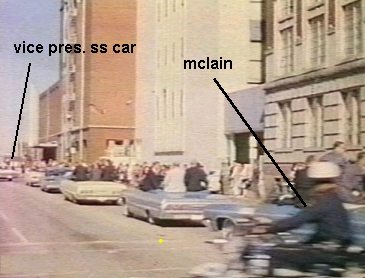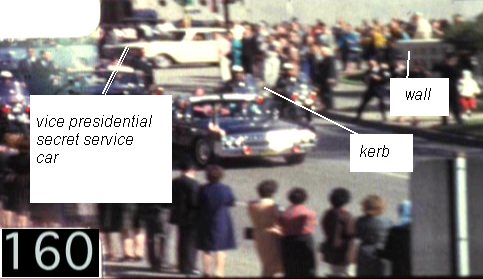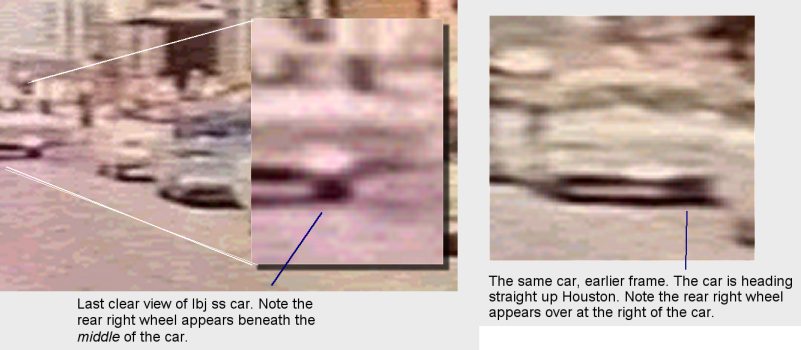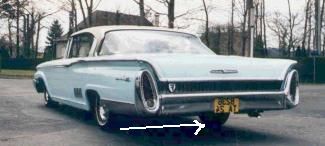


|
Map of this section |
|
| This page | Intro |
| Theory | The theory behind the measurements |
| Conclusion | What the theory demonstrates in this case. WARNING !! Due to embedded java applet, page takes a few moments to load !!! |
| Houston Contour Map | The lie of the land on Houston Street |
| Hughes position | Where exactly was Robert Hughes when he shot this frame of his film? |
| McLain's speed | What speed was he doing at the Main-Houston turn? |
| Dorman Movie | Desperately Seeking H B McLain |
| Dorman Versus Zapruder | Matching the Dorman, Weigman & Zapruder Films |
| Weiss & Aschkenasy | Acting On Impulse |
"On the basis of "acoustic evidence" provided by a Dallas Police Department Dictabelt tape, the
House Select Committee on Assassinations concluded that there were at least four shots in Dealey Plaza, and that
one of them came from the Grassy Knoll. The Dictabelt recorded a cop's microphone that had stuck in the open position
during the minutes of the assassination. Nobody can actually hear shots on the Dictabelt, but an elaborate statistical
analysis isolated fours sets of "impulses" that the House Committee's acoustic consultants asserted were
shots.
An explosive finding, if true. "
http://mcadams.posc.mu.edu/acoustic.htm
Don Thomas recently breathed new life into the issue :
"When I first wrote my article on the acoustics, I submitted it to the Journal of Forensic Science here in the United States for publication. The editor kicked it back, stating that it was their editorial policy not to publish articles on the Kennedy assassination. He defended this policy on the grounds that no amount of reanalysis was going to change anyone's mind. As one who routinely reviews scientific articles for publication, I must say that this seemed like an odd position for a scientist to take."
http://www.geocities.com/whiskey99a/dbt2002.html
http://pages.prodigy.net/whiskey99/thomas.pdf
The proposition that McLain could not possibly have been 'in the right place at the right time' has been argued by Greg Jaynes :
http://mcadams.posc.mu.edu/jaynes/
.. and some of Jaynes's arguments are reworked here.
Mike Russ has some highly relevant observations at:
http://www.geocities.com/jfkinfo4/sync/sync.htm
& he also has the original HSCA reports online :
http://jfkassassination.net/russ/jfkinfo/jfk8/sound1.htm
http://jfkassassination.net/russ/jfkinfo/jfk8/sound.htm
| The acoustic analysis by BB&N requires McLain to be at the junction of Houston & Elm at the time Zapruder frame 175 was shot. McLain appears in the Hughes film in the frame opposite, where the LBJ SS follow up car is apparently beginning to take the turn onto Elm further up the street. |  |
 |
Zapruder frame 160 shows the LBJ SS car making the turn onto Elm in the background. If, for example, the Hughes frame (above) & the Zapruder frame (left) happened to be taken synchronously, then this would leave McLain a mere 15 Z frames = 0.82 seconds to travel about 220 feet, if he is to reach the Houston-Elm junction in time to record the supposed shots. This would mean a speed of around 183 mph - obviously out of the question. |
| The map (right) shows the approximate situation in the Z frame above. |  |
The enlargements below show that the LBJ SS car is indeed turning, in the Hughes frame :

Below, a Mercury Parklane, 1960. Note the rear wheel position beneath the middle of the car, and the angle it is
at to the viewer. The LBJ SS car is at a similar angle to the line of the road.

The crucial question then becomes " At what point - in the Z film - was the Hughes frame (above) shot? If it was shot 'late' enough into the Z film - as for eg frame 160, above - then McLain cannot possibly reach his supposed 'acoustics' location in time to record any shots. An equivalent question, and the one we shall address here, is "How far up Houston Street is the LBJ SS car in the Hughes frame ?".
continue to explanation of the measurement method